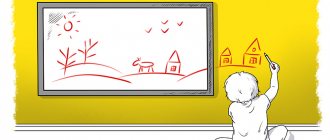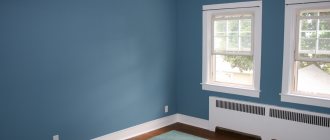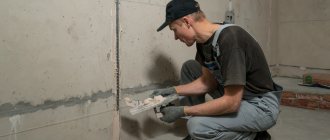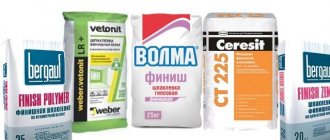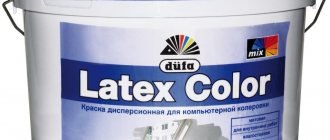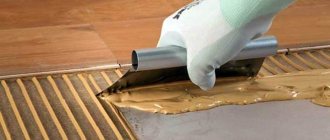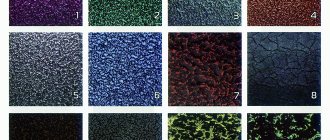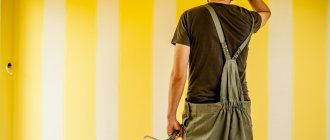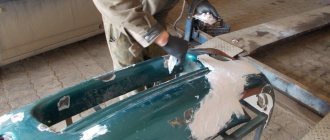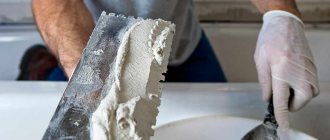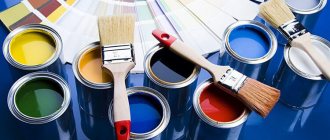Comparative analysis
This table will help you make a comparative analysis of textured paint and decorative plaster, thanks to which you can see the difference and make a choice.
| Textured paint | Decorative plaster | |
| Environmental friendliness | High | High |
| Application | Simple | Medium difficulty |
| Irregularities in the base | Hides small defects | Completely hides base defects |
| Lifetime | 10-30 years | 30-60 years |
| Mechanical resistance | Average | High |
| UV resistance | Stable | Stable |
| Moisture resistance | Average | High |
| Dismantling | Medium difficulty | High difficulty |
| Reconstruction | Amenable | Amenable |
| Vapor permeability | High | Excellent |
| Flammability | Non-flammable | Does not burn |
| Appearance | Attractive | Attractive |
| Price | Expensive and average | From cheap to expensive |
Caring for decorative coatings
Only 2 weeks after completion of work can the decorative plaster of the walls be washed. Walls with the effect of silk, velvet, corduroy and flock are washed with a soft cloth soaked in water. No brushes! The maximum is a sponge and a solution with soap. A soft brush for washing finishes with quartz filler, which is resistant to abrasion, is allowed. Wash the varnish or wax surface with a soft cloth using water, soap solution or dishwashing detergent. The Venetian is wiped with a damp soft cloth. Areas that are heavily soiled can be washed using a diluted soap solution.
Various types of decorative plasters have firmly taken their place in interior decoration; the coatings created have a number of amazing positive properties. When deciding to use such coatings, choose carefully and the result will not disappoint you.
What to pay attention to
Textured paint or decorative plaster are not cheap materials. And in order for the repair to be of high quality and satisfy the needs of a fastidious buyer, when purchasing facing material it is worth paying attention to some factors.
Appearance
Decorative coating can imitate wood, sand, leather, marble, granite, stone or block masonry and other equally interesting motifs. Also important is the color of the material, which should be combined with furniture, curtains and other interior items.
Decorative wall decoration should be combined with interior items in the room
The color is selected taking into account the lighting. For rooms with windows facing north, choose light colors. For rooms on the south side - a dark shade. The type of texture is also important - matte, pearlescent, glossy.
A soothing matte color is suitable for the bedroom, gloss or pearl for the living room.
Consumption of materials
For a smooth surface, use regular paint. A textured mixture is chosen to hide minor surface irregularities. The packaging indicates the paint consumption per 1 m² in one application.
For large differences and blockages on the surface, on top of brick and concrete masonry, it is better to use decorative plaster. As a result, both material consumption and repair time are reduced. But we must take into account that in this case there is much more plaster than paint.
Decorative plaster is used when there are large differences in the building base
Life time
The service life of the facing material depends on the components. If a small part of a painted wall has become unusable, then painting only this area will not work - the difference in tone will stand out and be unpleasantly noticeable. The entire wall will have to be repainted. Accordingly, the service life of such paint is short, since it is afraid of mechanical damage, frost and ultraviolet radiation.
Structural paint is an order of magnitude higher quality than enamel and water-based emulsion, and it lends itself better to restoration. If damaged, there is no need to redo the entire surface, but only restore the desired area. The textured mixture more easily withstands impacts, scratches, and rubbing with clothes and lasts 10-15 years, and some types - up to 30 years.
Decorative plaster has maximum durability
Decorative plaster breaks all records in terms of service life, as it can last from 30 to 60 years. It is difficult to damage it unless you specifically try to do so.
Calculation of paint consumption
The paint packaging indicates the approximate consumption per square meter. Knowing the area of the walls, you need to take into account that the paint is applied in two layers, so the consumption indicated on the can is multiplied by the area of the surfaces to be painted, and then again multiplied by two (layers of paint). To the resulting figure we add 25% for unforeseen expenses. The more relief the decorative plaster has, the higher the paint consumption will be.
Paint is applied to decorative plaster using a roller, brush or spray. If the work will be done with a roller, you need to buy a paint tray; it’s convenient to dip the tool into. At the same time, consumption is reduced due to the fact that the edge of the tray is made in the form of pimples - excess liquid is removed from them.
Textured plaster can be painted with a spray gun.
If the wall covering is prone to crumbling, then before painting it is necessary to treat the surfaces with a colorless primer. Plaster mixtures that are made on the basis of cement mortars are prone to crumbling.
The primer will give the walls and ceiling additional strength. You can apply the primer in one or two layers. The second layer is applied after the first has dried.
To understand whether the walls are prone to crumbling, you need to run a dry hand over the surface - if there are traces of any construction or finishing materials on your hand, then the walls may crumble over time.
To prevent the paint from splashing, a nylon thread is fixed to the surface of the can - it can be used to remove excess paint from the brush.
Differences in the use of materials
Plaster with a decorative effect is used to decorate walk-through rooms and rooms with high humidity. Despite the high cost, it is worth it, since the repair lasts for many years.
Walls that have the least contact with people are covered with patterned or white textured wallpaper, which is then painted. Surfaces that will be subject to constant contamination are painted with regular paint. They are subsequently wiped with a damp cloth and detergent.
Decorative plaster is excellent for rooms with high humidity
They try to decorate only one wall with textured paint, and cover the adjacent walls with another material. A room decorated in this way looks more comfortable, and the unevenness of the coating does not become boring over time.
Applying plaster to paint
Almost all instructions for finishing building materials require removing old plaster before applying them to the surface.
If you ignore this advice, the new decorative finish will quickly disappear after the renovation. If the old layer of plaster does not stick well to the wall, it can be easily removed with a spatula. - read in another article
Once the surface coating is well preserved, it is difficult to remove. In such situations, the most experienced professionals do not know what to do correctly. It is sometimes possible to deviate from the universal technique and apply a layer of plaster over the paint.
It is easier to lay plaster on rough walls
Most often this is done when finishing walls painted with water-based paint. When you don't want to clean a large area of paint, you can also apply plaster to the paint.
- Check the condition of the surface. Remains of the old layer that peel off must be removed. Otherwise, after leveling, the new plaster will quickly disappear.
- Adhesion begins to increase. First, using fairly coarse sandpaper (no. 60 or no. 80), clean the surfaces that have been painted. They are trying to remove dirt from the wall along with the top layer of paint.
- If the kitchen is being plastered, at the same time as cleaning, the surfaces are degreased with solvents to get rid of greasy stains that prevent the plaster from adhering to the wall.
- After sanding is completed, dents are made into the surface using an old ax. This can be done with a chisel or chisel. The depth of the cuts should exceed the thickness of the future decorative layer. It is considered optimal to have about 100 notches per 1 m2.
- The walls are cleaned of dust and dried.
- After completing the preparatory work, the walls are primed and leveled - a layer of plaster is applied.
- Gives the walls a rough appearance. If the walls are rough, then the plaster will adhere smoothly and firmly to the paint. The easiest way to solve this problem is to apply .
- The mixture is applied to the treated wall with a roller or brush. Care is taken to ensure that the compound penetrates into the recesses without fail.
- After the primer layer has completely dried, a plaster mesh is installed on the wall plane. To learn how to prepare walls, watch this video:
If you plan to apply a leveling layer of more than 10 mm, then you must use it.
Features of textured paint
Walls painted with structural paint are similar in appearance to decorative plaster. This similarity is associated with the addition of fillers to the paint and varnish composition, which increase the viscosity and granularity of the mixtures:
- marble or granite chips;
- quartz sand;
- metal and wood sawdust;
- synthetic fiber.
Fillers that increase the viscosity and graininess of textured paint
Also, to add color and shimmer, colored or pearlescent particles are added to it. When choosing a white mixture, color and reflective particles are added independently to the desired shade.
In this case, there is a drawback - in large quantities it is difficult to achieve the same tone throughout the mass. But hardware stores have shakers, and for a fee you can mix the entire composition until smooth.
Kinds
In addition to external factors, dyes are mixed on different bases. Depending on the main component, textured paint is used for its intended purpose:
- Acrylic - resistant to external factors, used both indoors and outdoors.
- Vinyl - used for facade treatment.
- Silicate is an expensive and durable paint that is applied to the exterior of buildings.
- Latex - used in living rooms and with caution - in rooms with high humidity.
- Polymer - has a lot of positive characteristics, and is also much more durable than its analogues.
- Polymer-cement is a mixture where the filler is fine-grained artificial cement.
- Silicone is an expensive and durable paint, used to decorate facades and walls in rooms with any humidity.
Types of textured paint by purpose
After the type of main composition is determined, the texture is selected.
Paint selection
Depending on which additional components serve as fillers, the coating relief is created:
- Silk is formed using synthetic and natural fabrics.
- Fur coat - obtained by adding granite chips or quartz sand.
- Marseilles wax - imitates rock stone.
- Atacama - sand and shimmering particles create a shiny metal, this is especially visible when fluorescent light is present.
- Mazuri - acrylic and modified starch create a wave-like structure.
- Shagreen - the result is a wrinkled surface.
- Mosaic - multi-colored granules and chips make the wall bright and voluminous.
- Mother of Pearl - Crushed mother of pearl shell adds shimmer.
- Craquelure is the artificial creation of cracks.
Silk
Relief Shuba
Marseille wax
Textured Atacama coating
Mazuri
Shagreen
Mosaic
Nacre
Craquelure
Recently, surfaces are often given a cracked appearance. The base coat of paint is visible through the cracks. This effect is achieved when a craquelure composition is applied, and after drying it is additionally coated with varnish.
Craquelure is divided into one-step and two-step, which is the most labor-intensive. The application technique is complex; to decorate the interior with a similar pattern, a professional is invited.
Those who like to create unique coatings can experiment by mixing 2-3 types of paints, or add fillers in the form of sand, mineral chips, and mother-of-pearl. And by adding color, you get the desired shade.
To obtain textured effects, you can mix several types of paints.
Preparation
The plane is initially cleaned of the old coating, dust and crumbling particles are removed with a brush. The wall is covered with deep penetration soil twice: vertically and horizontally. Before removing irregularities on the surface, use a laser or bubble level to check the walls and corners for geometry. If necessary, the verticals and horizontals are set with starting putty.
Stages of surface preparation for painting
Although applying textured paint does not require a perfectly flat surface, efflorescence, mold, rust, chips, screw heads, cracked parts and gouges must be removed.
The recesses are filled with fiberglass, and a layer of starting putty is applied on top. Reinforced tape is applied to the cracks, which is also reinforced with the base mixture, and the chips are covered. Efflorescence, mold and rust are removed with special chemicals purchased at a hardware store.
Mold and rust are removed from the surface with special preparations
The plane is checked for evenness using side lighting: the contours of the recesses and bulges are outlined with a slate pencil. Protruding areas are cleaned with a fine-grained grater, the recesses are filled with putty and leveled “to scratch.” Before applying paint, the walls are again treated with a primer. The material fits better on it.
Tools for work
To apply textured paint you will need:
- bath for soil;
- roller with a long handle and 1 cm pile;
- a structural roller for creating a pattern or another tool, depending on the intended pattern;
- spatulas;
- brushes;
- container for diluting paint;
- water.
Tools for applying textured paint
When adding color, an electric drill with a mixing attachment will help create a homogeneous mass.
Application process
Before starting work, it is necessary to protect your eyes, hair, and exposed skin from contact with the paint and varnish mixture. Liquid paint is applied with a roller. To make the mixture denser, use a spatula. The wall is painted completely at one time so that no joints between the old application and the new are visible. Until the coating has dried, create a texture within 1.5-2 hours using rollers, stencils, combs, sponges and other objects. It all depends on the flight of fancy of the master.
Methods of applying textured paint
After drying, a second coat of paint is applied to give the painting volume and enliven the overall appearance. Sometimes they are limited to only varnish or wax.
The final coating is mandatory, as it protects against mechanical damage, prevents dust and dirt from eating into the top layer, and extends the service life.
Advantages and disadvantages
In addition to individual features, these paints:
- environmentally friendly;
- non-flammable;
- hypoallergenic;
- hygroscopic;
- moisture resistant;
- applied to surfaces with different structures;
- resistant to the development of mold and other microorganisms;
- easily tolerate temperature changes and UV radiation;
- After application, they dry within 5-6 hours.
Textured paint is an environmentally friendly, hypoallergenic material that is resistant to temperature changes
The disadvantages include the impressive consumption of material - 2-3 times higher than the consumption of conventional dye, as well as its high cost. When covering 1 m², it costs from 250 to 1000 rubles - this does not include the cost of work. Another disadvantage is that dust gets clogged into the relief, despite the antistatic properties of the material, so it is washed more often. The third drawback is that during reconstruction the paint is completely removed, and this is not easy to do.
Process technology
Before you begin the procedure, you need to prepare the walls. It is best if the plaster is fresh and has been applied recently. In the case of an old coating, it must be restored:
- Plastered walls need to be checked for defects: depressions, bumps and cracks.
- Detected defects should be eliminated using putty.
- The dried leveling material must be cleaned with fine sandpaper, thus ensuring high adhesion to the surface.
Do not forget that if the renovation is carried out from scratch, then at least 60 days must pass from the moment of applying cement plaster to the start of painting work. This period is due to the fact that during the drying process, plastered walls are prone to shrinkage. If you try to apply paint during this period, there will be a high risk of it falling off in the near future.
Prepare all the necessary tools, as well as the material with which the wall will be painted. Next, proceed to preparing the putty surface:
- Clean the surface from possible dust and dirt using a wide brush with stiff bristles.
- Prime the surface with a deep penetration compound - the plaster has large pores that the primer will fill perfectly.
- Before painting the plaster, wait until the wall is completely dry.
Sometimes owners wonder: is it possible not to prime the walls before painting. The answer will be clear: a surface covered with primer always adheres better to finishing materials. Do not neglect this stage of preparation.
For large industrial premises it is more advisable to use a spray gun, but for living rooms you can get by with a brush and roller.
Painting walls after plastering is considered a simple procedure that can be carried out by a person who does not have skills in such work. The process consists of several stages:
- Dilution of paint. Open the jar of the mixture and mix it a little with a brush. To obtain the required color, use a tint. If alkyd or oil paint is used, add a little solvent to the mixture in accordance with the manufacturer's instructions.
- Before painting the surface, pour a little mixture into a container to break in the tool.
- It is advisable to carry out interior work with constant air circulation, thereby ensuring the safety of the master and facilitating quick drying of the paint.
- Take some paint onto the roller and roll it up and down the wall. Continue to process the entire surface of the wall with these movements. Make sure that the roller does not leave streaks, this may be due to the abundance of paint on the sides of the tool.
Do not forget to cover all items during finishing to protect them from the coloring composition. Cover the areas that do not need painting with masking tape.
As you can see, the procedure for painting walls covered with plaster is quite simple. To do this, you just need to choose the right composition and set of tools. The results will bring you joy and help you improve your skills.
How to paint plaster correctly (2 videos)
Textured plaster
The last stage of surface finishing is painting the textured plaster yourself. Depending on the chosen color and quality of painting, a general impression of the style of the building will be created. In addition to giving an aesthetic appearance, the paint protects the surface from atmospheric influences; the lightened tone will reflect heat from the walls of the building, therefore, the service life of decorative plaster will increase.
Decorative plaster
Such plaster is much stronger and more durable than textured paint, but it is not always possible to determine from the appearance of a finished wall whether it is plastered or painted.
The advantages of textured plaster include strength and durability
What happens
Like textured paint, plaster has different decorations that are no less attractive:
- Venetian - imitates polished marble;
- under natural stone - imitation travertine (lime tuff);
- world map - resembles the earth from space;
- bark beetle - creates the appearance of passages eaten away by bark beetles;
- brickwork;
- concrete;
- with the effect of cracks (craquelure);
- tree.
Venetian plaster
Types of decorative plaster relief
Decorative plaster “Travertine”
Plaster “World Map”
Mother-of-pearl, color, fillers and other ingredients are added to plaster, just like to paint, depending on what texture the master intended to create.
Rating of plasters
The ranking of the most popular plasters of 2021 includes both budget options and premium products:
- Aura Dekor Putz - decorative plaster for budget renovation, made in Russia, price for 1 package of 25 kg - 2200 rubles.
- Perel Acrilico is a texture base for the color, the pattern is bark beetle, made in Russia, the cost of 18 kg of packaging is 1,400 rubles.
- Optimist-Elite D 727 - acrylic plaster with polymer additives, pattern - Venetian, manufacturer - Russia, price - 3900 rubles. for 15 kg.
- Finncolor Mineral Decor - a universal mineral composition based on acrylic resins, texture - fur coat, country - Finland (produced in Russia), price - 1200 rubles. for 16 kg.
- Dali-Decor is a popular high-quality acrylic mixture with a glossy surface, image - Venetian, manufacturer - Russia, price - 2300 rubles. for 15 kg.
- Dufa MODELLIERPUTZ - acrylic resins with polymers, the plaster does not have its own pattern, a modeling mixture, the texture of which is created manually, country - Germany, produced in Russia, cost - 1960 rubles. for 18 kg.
- Quick-mix MODELLIERPUTZ is a simple modulator plaster based on cement, lime and gypsum, created in Germany, produced in Russia, price - 670 rubles. for 25 kg.
- Lakra - decorative plaster with a fur coat effect, a budget option with good quality, manufacturer - Russia, price for 15 kg - 1100 rubles.
- Initiatives Decoration is a product with expensive fillers: marble chips and mica, the finished surface can be washed even with chemicals, country - France, price - 3500 rubles. for 2 kg.
- VGT - a huge assortment with different texture patterns, consists of polymer material, country - Russia, cost - 1040 rubles. for 8 kg.
Rating of popular decorative plasters for 2021
The price indicated is approximate, since hardware stores are free to increase the percentage, as well as make promotions on this or that product.
Preparatory work
Like textured paint, decorative plaster is most often applied over putty. But there are compositions that cover bases made of a different material. The preparation technology is always the same: make sure that the walls are smooth, remove chips and cracks, coat the surface with deep penetration soil.
Required Tools
In addition to a container and an electric drill for stirring the dry mixture, to cover the walls with decorative plaster you will need:
- rollers for applying texture;
- stencils, applicators and stamps;
- combs, brushes, sponges;
- grater for creating a pattern - bark beetle;
- trowel and trowel for the Venetian;
- metal and rubber spatulas.
Necessary materials for applying decorative plaster
To apply an individual image you need a certain tool. As auxiliary equipment you will need:
- roulette;
- level;
- masking tape;
- sandpaper;
- ladder.
Auxiliary tools required for work
You also need to remember to protect your eyes and exposed skin, wear a hat, overalls and comfortable closed shoes.
Application
There are several technologies for applying decorative plaster, it depends on the pattern with which you plan to decorate the walls. But a mandatory rule is that before the main work, the base is primed with a deep white primer on an acrylic base, and after the coating has dried, it is primed with sand. As a result, the surface becomes rough, which increases the adhesion of the plaster to the base, and the mixture lays down more easily.
The decoration is applied in one or several layers. Sometimes one layer is enough, but to add volume, add 2-3 layers.
To add volume, it is recommended to apply 2-3 layers of decorative plaster
Craftsmen use manual coating methods and using a spray gun. Manual movements are made in a circle, stroke, stretching, sketching, leveling. To master the technology of applying a specific pattern yourself, you need to study the technology and watch a video.
Advantages and disadvantages
Decorative plaster is a worthy alternative to wallpaper and paint, and has a number of advantages:
- ease of application;
- no seams are formed;
- hides unevenness of the base;
- environmentally friendly;
- durable;
- resistant to external factors;
- moisture resistant;
- if damaged, it can be easily restored;
- attractive appearance.
The decorative composition is easy to apply and allows you to hide minor wall defects
Disadvantages include the high cost of some types of plaster, the expensive cost of work when hiring professionals, and the difficulty of dismantling.
Decorative coating is a more expensive material than simple paint and wallpaper. For those who do not consider it necessary to carry out reconstruction every few years, which causes residents to experience inconvenience and discomfort for several days, or even months, these types of cladding are suitable. And then a good, durable repair will delight the household for many years.
Have you ever had to make a choice between textured paint and decorative plaster? What did you decide in favor of? What influenced him? Share your opinions in the comments.
How do such products differ from other paints and varnishes?
For many people who have not previously encountered construction or renovation, it will be difficult to answer the question of how decorative paints differ from other coloring compositions (decorative plasters or ordinary paints). In fact, there is practically no difference - they have a thicker consistency and contain different additives. However, decorative paint was developed with the aim of embodying a variety of wall design ideas, decorating surfaces with imitation of different textures.
Of course, simple painting compositions can also be used for original wall decoration, but you will need to take into account the structure of the base being treated, as well as follow a special application technology.
Decorative coatings (paints and plasters), on the contrary, allow you to create different effects on the surface without much effort. For example, there are ones that, due to the additives included in the composition, allow you to create an imitation of wood or other material, as well as obtain a surface with the effect of silk, velvet (velor), mother-of-pearl, gold and many other options.
All these visual effects on wall surfaces are formed due to special additives and the consistency of a special plastic element that is present in the solvent intended for diluting paint. Such additives can change the physical properties of the base mixture and therefore, after it dries, unusual decorative patterns are obtained. In an effort to make their home not only cozy, but also beautiful inside, many resort to decorative coatings. With their help, you can carry out all finishing work with high quality without much difficulty, and the result will definitely exceed all expectations.
Advantages and disadvantages of decorative paint
Let us immediately clarify the difference between decorative paint and ordinary paint. Decorative paint (DC) is distinguished by the presence of additional components that increase the viscosity and thickness of the material.
- calcium carbonate (chalk with very small particles - up to 10 microns);
- thickeners (polyurethane, acrylic, water-soluble cellulose ethers);
- structuring additives (water-soluble silicates, bentonite or kaolin clays, amorphous silicon oxide).
Mixtures may also contain structuring inclusions:
- fibers (natural or artificial);
- quartz sand, small stone chips, artificial granules;
- metal filings or dust;
- nacre;
- flocks.
In terms of viscosity, DC can be close to putty. Thanks to this, DC, even having the same base as regular paint, allows you to create finish coatings with a wide variety of textures and relief patterns.
The mass is held on a spatula, does not flow down the wall, being applied in a layer of up to 10-15 mm, it is formed in different ways and with tools.
- textured;
- mosaic (with coloring granules);
- flock (including flakes);
- with special effects (for example, luminescent, mother-of-pearl, craquelure).
This is a magical tool for realizing fantasies of any level (from amateur to highly artistic). Decorative potential is the first advantage of a recreation center.
Components of plaster mixtures
The properties and purpose of a particular type of decorative plaster depend on its composition.
- Gypsum and lime are traditional fillers that ensure its strength, plasticity, good adhesion to the base, hygroscopicity and air exchange.
- Acrylic, silicone, latex are components that make the coating elastic and resistant to moisture.
- Silicate glass is a strengthening ingredient that makes the plaster resistant to moisture, temperature changes and reduces the adhesion of dirt. In addition, the fire resistance of the coating increases.
- Quartz or marble chips are elements that form an expressive texture and natural shine to imitate the surface of natural stone.
- Pigments and colors - to give the coating the desired shade.
- Cellulose, nylon and other fibers, metallized threads - to create specific decorative effects.
It is necessary to carefully study the description and characteristics of the selected mixture, which must indicate for which rooms or external walls the coating is intended, and under what conditions it can be used.
Glass-based silicate
Silicate decorative plaster is mainly used for facade decoration due to the fact that it emits harmful substances. It is based on glass and this results in the coating setting very quickly. Therefore, you need to work with such material quickly and in pairs. However, this mixture also has a number of advantages:
- The shelf life is 60 years.
- Not afraid of mold or mildew.
- Has water-repellent properties.
- Fire safety.
Materials and tools
Set of plasterer tools: graters, spatulas, brushes, stamps
When starting work on applying decorative plaster, you should make sure you have the necessary tools. We will need:
- wall primer brush;
- trowel;
- metal grater;
- a set of spatulas (at least one narrow one for scooping out the solution, and one wide one for smoothing);
- tools for applying texture (smooth and textured rollers, figured spatulas, sponges, etc.);
- brushes and rollers for painting surfaces;
- measuring instruments - plumb line, level, tape measure.
Shaped attachments for rollers and photos of treated surfaces
Note! Despite the fact that decorative plasters can partially hide the unevenness of the wall, in some cases it may be necessary to level it with plaster or drywall.
Tinted decorative plaster Provence: you can create almost any pattern with your own hands
From materials we will need the plaster mass itself. Below we give the estimated cost of various brands, so you can plan your budget in advance:
| Brand | Unit | Average cost, rub. |
| UMCOS “Bark beetle” façade | 20 kg | 2000 – 2500 |
| Rauf Décor GRANULUM | 15 kg | 1300 – 1600 |
| Dufa Model | 18 kg | 1400 -1600 |
| Decor de Provence Base | 21 kg | 7000 – 8500 |
| San Marco Intonachino Minerale | 25 kg | 6200 – 7000 |
| Le Mas de Provence | 21 kg | 6000 – 6300 |
Note! The larger the volume of material, the lower the price per kilogram, so by purchasing the composition at once for a large area, you can save significantly. Consumption depends on the specific brand, and can range from 400-600 g/m2 (Venetian plasters) to 2.5 - 3 kg/m2 (Bark beetle).
San Marco Intonachino Minerale coating with a clear grain structure
In addition to the plaster itself, for finishing you may need:
- mineral additives for tinting or exterior decoration - about 150 - 200 rubles / 100 g;
- paints for exterior decoration - from 250 rubles for the simplest ones and from 700-800 rubles for specialized metallics and pigments to imitate the texture of stone;
- varnishes and waxes for finishing - approximately from 700-900 rubles per 1 liter.
Naturally, if we need to level the surface to apply the decor, then the materials for it will need to be purchased separately.
Tinting composition for waxing
Advice! To accurately select the shade, tinting can be done on a special computer stand. Large stores that sell finishing materials often provide such services at quite affordable prices, and for large volumes of purchases – even free of charge.
